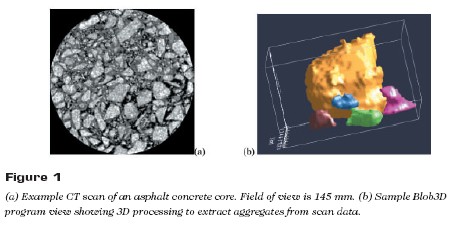The project developed an asphalt pavement evaluation methodology based on high-resolution X-ray computer tomography (CT) to obtain three-dimensional imagery of asphalt concrete. The thrust of the project was to develop a software application called “Blob3D” which utilizes industrial high-resolution X-ray computed tomography (CT) data to provide quantitative, nondestructive evaluation of asphalt concrete pavements (Figure 1). The project accomplished the initial conception, design, and development of the software program to obtain the required analysis. During the first phase, the program architecture was laid out and the data analysis was divided into three stages: segregation, separation, and extraction. Software to accomplish each of these tasks was developed in parallel and successively improved and tested to achieve a working package. Once a CT data volume has been segmented and separated, it can be mined to get the desired data. The data that can be extracted from the system includes particle (or void) volume, center of mass, surface area, aspect ratio, long axis orientation, and location, direction, and surface area of all particle-particle contacts. A series of controlled tests was performed to verify that the information produced by the analysis was correct. In all cases, the test results met expectations. The technology will be further evaluated at the FHWA in a systematic investigation of core samples obtained from experimental mixers and from field tests such as West Track.
The techniques developed in this project can aid in the formulation of mixing methods by comparing experimentally mixed cores; poor-performing mix designs can be identified and eliminated. Such an analysis can also be used as a forensic tool to investigate pavement failures. These investigations should allow building higher-quality and more durable pavements, with large indirect savings from reduced need for maintenance and replacement. Five hundred million tons of asphalt concrete is laid down each year as overlays, full-depth pavements, and other applications, at a cost of up to $15 billion. Any incremental savings enabled by improved pavement design should result in considerable savings. Reduced wear on vehicles due to better pavements also constitutes an indirect but potentially large payoff. The final report is available from the National Technical Information Service (NTIS # PB2001-102198).

The final report for this IDEA project can be found at:
https://onlinepubs.trb.org/onlinepubs/archive/studies/idea/finalreports/highway/NCHRP064_Final_Report.pdf